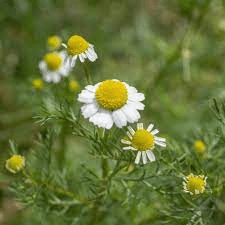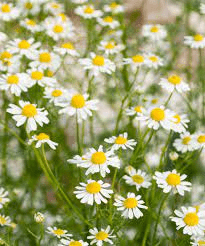Matricaria chamomilla, commonly known as Chamomile, is a small, flowering herb belonging to the Asteraceae family. Native to Europe and Western Asia, Chamomile is renowned for its delicate, daisy-like flowers and is widely cultivated for its medicinal and therapeutic properties.
Morphologically, Chamomile grows to a height of 15 to 60 centimeters, with feathery, finely divided leaves. The flowers, which resemble miniature daisies, have a yellow central disc surrounded by white, ray-like petals.
There are two main types of chamomile: German chamomile (Matricaria chamomilla or Matricaria recutita) and Roman chamomile (Chamaemelum nobile). Both varieties are used for similar purposes, with German chamomile being more commonly employed in herbal medicine.
Chamomile has a long history of use in traditional medicine, dating back to ancient times. The dried flowers of Chamomile contain various bioactive compounds, including chamazulene, apigenin, and bisabolol, which contribute to its anti-inflammatory, antispasmodic, and calming effects.
One of the most well-known uses of Chamomile is in the preparation of herbal teas. Chamomile tea is consumed for its soothing properties and is often recommended for promoting relaxation and easing digestive discomfort.
The herb is also used topically in the form of infusions or essential oil for various skin conditions, including mild irritations and inflammations.
Chamomile’s anti-inflammatory and calming effects extend to its potential use in promoting sleep and reducing anxiety. It is often included in herbal blends designed to induce relaxation and improve sleep quality.
Culturally, Chamomile has been used for its symbolic and ritualistic significance. It was historically associated with deities related to the sun and used in various herbal traditions to invoke relaxation and peace.
While Chamomile is generally considered safe, individuals with allergies to plants in the Asteraceae family (such as ragweed, marigolds, or daisies) should exercise caution. Additionally, pregnant individuals should consult with healthcare professionals before consuming Chamomile in medicinal amounts.
The versatility of Chamomile, its pleasant aroma, and its potential therapeutic benefits contribute to its continued popularity in herbal medicine and as a calming herb in various cultural practices.
The Botanical Description of Chamomile
1. Growth Habit: Chamomile, a member of the Asteraceae family, is a low-growing herbaceous plant with delicate, feathery leaves.
2. Leaves: The leaves are finely dissected, giving them a lacy appearance, and emit a mild, pleasant fragrance when crushed.
3. Flowers: Chamomile is renowned for its daisy-like flowers with a bright yellow central disc surrounded by white petals. Each flower is approximately one to two centimeters in diameter.
4. Stem: The stems are thin, erect, and can reach a height of 15 to 60 centimeters, depending on the species.
5. Root System: Chamomile has a fibrous root system that anchors the plant in well-drained soils.
6. Aroma: When touched or gently brushed against, Chamomile releases a sweet, apple-like aroma.
7. Blooming Period: The blooming period typically occurs in late spring to early summer, with flowers appearing in abundance.
8. Habitat: Chamomile thrives in sunny locations with well-drained soil, often found in meadows, fields, and along roadsides.
9. Varieties: There are two primary varieties of Chamomile used for medicinal purposes: German Chamomile (Matricaria chamomilla) and Roman Chamomile (Chamaemelum nobile). German Chamomile is an annual, while Roman Chamomile is a perennial.
The Geographic Distribution of Chamomile

1. Europe: Chamomile is native to Europe and Western Asia, where it has a long history of traditional use.
2. North America: It has been naturalized in North America and can be found in various regions, especially in the temperate zones.
3. Australia: Chamomile has also adapted to certain regions of Australia, where it is cultivated for its medicinal properties.
4. Asia: While not native to Asia, Chamomile has been introduced and cultivated in some parts of the continent.
5. Cultivation Worldwide: Due to its popularity and diverse uses, Chamomile is now cultivated worldwide in regions with suitable climates.
6. Altitude Range: Chamomile can be found at a range of altitudes, from lowland areas to moderately elevated regions.
7. Temperate Climates: Chamomile prefers temperate climates, thriving in areas with distinct seasons.
8. Well-Drained Soils: The plant shows a preference for well-drained, sandy or loamy soils with good sunlight exposure.
The Chemical Composition of Chamomile
1. Chamazulene: This compound is responsible for the characteristic blue color in Chamomile oil and exhibits anti-inflammatory properties.
2. Bisabolol: Known for its anti-inflammatory and skin-soothing properties, bisabolol contributes to Chamomile’s medicinal benefits.
3. Apigenin: A flavonoid with antioxidant properties, apigenin is associated with various health benefits.
4. Coumarins: Chamomile contains coumarins, which may contribute to its anticoagulant and blood-thinning effects.
5. Farnesene: This sesquiterpene has anti-inflammatory and antioxidant properties.
6. Alpha-Bisabolol Oxide: Another compound with anti-inflammatory effects, contributing to the plant’s therapeutic potential.
7. Flavonoids: Chamomile is rich in flavonoids, which possess antioxidant, anti-inflammatory, and immune-boosting properties.
8. Luteolin: A flavonoid known for its anti-inflammatory and anti-cancer properties.
9. Terpenoids: Chamomile contains various terpenoids, contributing to its aromatic properties and potential health benefits.
10. Caryophyllene: Exhibiting anti-inflammatory and analgesic effects, caryophyllene is found in Chamomile essential oil.
11. Myrcene: This terpene contributes to the sedative and relaxing effects of Chamomile.
12. Pinene: Chamomile contains pinene, a compound with anti-inflammatory and bronchodilator effects.
Read Also: 20 Medicinal Health Benefits Of Night Blooming Cactus (Epiphyllum oxypetalum)
The Medicinal Health Benefits Of Chamomile (Matricaria chamomilla)

1. Calming Effects: Chamomile is renowned for its calming properties, promoting relaxation and reducing stress and anxiety.
2. Digestive Support: It aids in digestion by relaxing the muscles of the gastrointestinal tract, reducing symptoms of indigestion and bloating.
3. Sleep Aid: Chamomile tea is a popular remedy for promoting sleep and alleviating insomnia, thanks to its mild sedative effects.
4. Anti-Inflammatory Properties: Chamomile’s anti-inflammatory compounds may help reduce inflammation in conditions like arthritis.
5. Skin Health: Applied topically or used in skincare products, Chamomile can soothe irritated skin, reduce inflammation, and promote wound healing.
6. Menstrual Pain Relief: Chamomile tea may help alleviate menstrual cramps and discomfort due to its muscle-relaxant properties.
7. Immune Support: The antioxidant-rich profile of Chamomile supports overall immune function.
8. Respiratory Relief: Inhaling Chamomile steam can provide relief from respiratory conditions, including colds and allergies.
9. Anti-Anxiety Effects: Chamomile’s calming effects extend to reducing symptoms of anxiety and promoting a sense of well-being.
10. Anti-Bacterial Properties: Chamomile possesses mild antibacterial properties, contributing to oral health when used in mouthwash or oral care products.
11. Anti-Allergic Effects: Some studies suggest that Chamomile may help alleviate symptoms of allergies due to its anti-inflammatory effects.
12. Relief from Migraines: Chamomile tea, with its calming properties, may provide relief from migraine headaches.
13. Cardiovascular Health: Compounds in Chamomile may contribute to cardiovascular health by supporting normal blood pressure and circulation.
14. Antioxidant Effects: Chamomile’s flavonoids and terpenoids act as antioxidants, protecting cells from oxidative stress.
15. Muscle Relaxation: Chamomile’s muscle-relaxant properties extend to skeletal muscles, providing relief from tension.
16. Relief from Inflammatory Skin Conditions: Chamomile’s anti-inflammatory effects make it beneficial for conditions like eczema and dermatitis.
17. Gastrointestinal Soothing: Chamomile’s relaxant effects on the gastrointestinal tract can soothe symptoms of irritable bowel syndrome (IBS) and colic.
18. Diabetes Management: Some research suggests that Chamomile may help manage diabetes by regulating blood sugar levels.
19. Cancer Prevention: Certain compounds in Chamomile, such as apigenin, have shown potential anti-cancer properties in preliminary studies.
20. Anti-Aging Properties: The antioxidant content of Chamomile contributes to its potential anti-aging effects by protecting the skin from free radical damage.
The Methods of Usage to Achieve the Provided Health Benefits Of Chamomile (Matricaria chamomilla)
1. Chamomile Tea: One of the most popular methods, drinking Chamomile tea is effective for promoting relaxation, aiding in sleep, and providing digestive support. Steep dried Chamomile flowers in hot water for a soothing beverage.
2. Topical Applications: Apply Chamomile-infused oils or creams to the skin for relief from skin conditions, irritation, and to promote wound healing. Ensure the product is suitable for topical use.
3. Inhalation: Inhale Chamomile steam to relieve respiratory issues. Add dried Chamomile flowers to hot water, create a tent with a towel, and inhale the steam for respiratory relief.
4. Chamomile Capsules or Tinctures: For a convenient and controlled dosage, consider Chamomile supplements in capsule or tincture form. Follow recommended dosage guidelines.
5. Chamomile Bath: Add Chamomile to a warm bath for a relaxing soak. This can promote overall well-being and soothe muscles.
6. Chamomile Mouthwash: Rinse your mouth with Chamomile-infused mouthwash to benefit from its mild antibacterial properties and support oral health.
7. Chamomile Essential Oil: Diffuse Chamomile essential oil for a calming atmosphere. It can also be diluted and applied topically for various benefits.
8. Chamomile Hair Rinse: Use Chamomile-infused water as a hair rinse to soothe the scalp and enhance hair health.
9. Chamomile Compress: Apply a Chamomile-infused compress to areas of the body experiencing pain or inflammation for localized relief.
10. Culinary Use: Incorporate Chamomile into culinary creations like salads, desserts, or as a flavoring for certain dishes. Ensure you are using the appropriate Chamomile variety.
The Side Effects Of Using Chamomile Medicinal Plant
1. Allergic Reactions: Some individuals may be allergic to Chamomile, leading to skin reactions, itching, or respiratory symptoms. Perform a patch test before topical use.
2. Pregnancy Precautions: Pregnant individuals should consult with a healthcare professional before using Chamomile, especially in concentrated forms, due to its potential to stimulate uterine contractions.
3. Allergic Cross-Reactivity: Individuals with known allergies to plants in the Asteraceae family, such as ragweed or marigolds, may experience cross-reactivity with Chamomile.
4. Blood-Thinning Effects: Chamomile may have mild blood-thinning effects, so individuals on blood-thinning medications should exercise caution and consult with a healthcare provider.
5. Sedative Effects: Chamomile’s calming properties may enhance the effects of sedative medications. Avoid excessive sedation by consulting with a healthcare professional.
6. Gastrointestinal Discomfort: In rare cases, Chamomile may cause gastrointestinal discomfort, including nausea or vomiting. Discontinue use if such symptoms occur.
7. Interaction with Medications: Chamomile may interact with certain medications, including anticoagulants, antiplatelet drugs, and sedatives. Consult with a healthcare provider if taking such medications.
8. Drowsiness: Some individuals may experience drowsiness after consuming Chamomile, especially when combined with medications that induce sleepiness.
9. Photoallergic Reactions: Exposure to sunlight after applying Chamomile oil topically may result in photoallergic reactions in some individuals.
10. Potential for Allergic Asthma: Individuals with a history of allergic asthma should use Chamomile with caution, as it may trigger respiratory symptoms.
11. Eczema Aggravation: In rare cases, Chamomile may aggravate symptoms of eczema in sensitive individuals.
12. Interference with Diabetes Medications: Chamomile may affect blood sugar levels, potentially interfering with diabetes medications. Monitoring is essential for individuals with diabetes.
13. Potential for Overuse: While generally safe, overuse of Chamomile may lead to unwanted side effects. Follow recommended dosages and usage guidelines.
Read Also: 15 Medicinal Health Benefits Of Spikenard (Nardostachys jatamansi)
The Scientific Research and Studies of Chamomile

1. Anti-Inflammatory Effects: Scientific studies have confirmed the anti-inflammatory effects of Chamomile, supporting its traditional use for inflammatory conditions.
2. Anxiolytic Properties: Research indicates that Chamomile may have anxiolytic (anxiety-reducing) effects, providing support for its calming properties.
3. Digestive Benefits: Studies suggest that Chamomile can relax the gastrointestinal tract, providing relief from digestive issues such as indigestion.
4. Sleep Improvement: Chamomile’s potential to improve sleep quality has been investigated, with studies supporting its mild sedative effects.
5. Antioxidant Activity: Scientific research confirms the antioxidant activity of Chamomile, which contributes to its cellular protection.
6. Wound Healing: Chamomile’s wound-healing properties have been studied, highlighting its potential in promoting skin regeneration.
7. Anti-Bacterial Effects: Chamomile has demonstrated mild antibacterial effects in scientific studies, supporting its use for oral health.
8. Anticancer Potential: Some compounds in Chamomile, such as apigenin, have shown potential anticancer properties in preliminary research.
9. Anti-Allergic Effects: Studies suggest that Chamomile may have anti-allergic effects, making it beneficial for individuals with allergic conditions.
10. Cardiovascular Impact: Research indicates potential cardiovascular benefits of Chamomile, including blood pressure regulation.
11. Respiratory Benefits: Scientific investigations support Chamomile’s respiratory benefits, especially in addressing symptoms of colds and allergies.
The Safety Precautions and Recommendations In Using Chamomile Medicinal Plant
1. Consultation with Healthcare Professional: Before incorporating Chamomile into your health routine, especially in concentrated forms or if you have existing health conditions, consult with a healthcare professional.
2. Dosage Guidance: Follow recommended dosage guidelines provided by healthcare professionals or reputable sources. Excessive consumption may lead to adverse effects.
3. Monitoring Blood Sugar Levels: Individuals with diabetes should monitor their blood sugar levels when using Chamomile, as it may affect glucose regulation.
4. Pregnancy and Lactation: Pregnant or breastfeeding individuals should seek guidance from a healthcare provider before using Chamomile, especially in concentrated forms.
5. Allergy Testing: Perform a patch test before using Chamomile topically to check for potential allergic reactions, especially if you have sensitive skin.
6. Blood Pressure Monitoring: Regularly monitor blood pressure, especially for individuals with existing cardiovascular conditions, as Chamomile may have mild hypotensive effects.
7. Individual Sensitivities: Be mindful of individual sensitivities and discontinue use if any adverse reactions occur. This is particularly important for individuals with known plant allergies.
8. Interaction with Medications: Inform healthcare providers about Chamomile use, especially if taking medications that may interact with its compounds.
9. Consideration of Individual Health: Chamomile is generally safe for most individuals, but considerations should be made for those with specific health conditions. If in doubt, seek professional advice.
10. Sustainable Harvesting: If harvesting Chamomile from the wild, practice sustainable harvesting to ensure the conservation of plant populations and their ecosystems.
11. Record Keeping: Maintain a record of Chamomile usage, including dosage and any observed effects, to facilitate discussions with healthcare providers.
12. Reporting Adverse Effects: Report any unexpected or severe adverse effects to healthcare providers and relevant regulatory authorities to contribute to the understanding of Chamomile’s safety profile.
FAQs About Chamomile Medicinal Plant
1. Is Chamomile Safe for Children?
Chamomile is generally considered safe for children when used in appropriate forms and dosages. However, it’s advisable to consult with a pediatrician before use.
2. Can Chamomile Cause Allergic Reactions?
While rare, some individuals may be allergic to Chamomile. Perform a patch test before topical use, and discontinue use if allergic reactions occur.
3. Can Chamomile Interact with Sedative Medications?
Chamomile’s calming effects may enhance the effects of sedative medications. Consult with a healthcare professional if using sedatives.
4. How Long Does it Take to Experience the Medicinal Benefits of Chamomile?
The time to experience benefits can vary. Consistent use, especially in the form of tea, may yield gradual results over time.
5. Can Chamomile Be Used During Pregnancy?
Pregnant individuals should consult with their healthcare provider before using Chamomile, especially in concentrated forms, due to its potential effects on uterine contractions.
6. Is Chamomile Safe for Long-Term Use?
Chamomile is generally safe for long-term use when used in moderation. Regular check-ups and monitoring are advisable.
7. Can Chamomile Cause Drowsiness?
Some individuals may experience drowsiness, especially when consuming Chamomile in combination with medications that induce sleepiness.
8. Can Chamomile Be Used Topically for Skin Conditions?
Yes, Chamomile-infused oils or creams can be applied topically for various skin conditions. Perform a patch test and discontinue if irritation occurs.
9. Can Chamomile Be Used as a Culinary Herb?
Yes, Chamomile flowers can be incorporated into culinary creations for added flavor. However, moderation is key.
10. Can Chamomile Cause Gastrointestinal Discomfort?
In rare cases, excessive consumption of Chamomile may cause gastrointestinal discomfort. Following recommended dosages is important to avoid such effects.
11. Can Chamomile Be Combined with Other Herbal Supplements?
Combining Chamomile with other herbal supplements should be done cautiously, and it’s advisable to seek guidance from a healthcare professional to avoid potential interactions.
12. Can Chamomile Be Used for Pets?
The use of Chamomile in pets should be avoided unless specifically recommended by a veterinarian. Pets may react differently to herbs, and professional guidance is crucial.
13. Is Chamomile Safe for Individuals with Liver Conditions?
Individuals with liver conditions should seek medical advice before using Chamomile, as some herbal compounds may affect liver function.
14. Can Chamomile Cause Photosensitivity?
Chamomile oil may cause photoallergic reactions in some individuals. Avoid sun exposure after applying Chamomile oil topically.
15. Can Chamomile be Used During Breastfeeding?
Breastfeeding individuals should consult with their healthcare provider before using Chamomile, especially in concentrated forms, due to potential effects on lactation.
16. Can Chamomile Be Used for Anxiety?
Chamomile’s calming effects may contribute to anxiety relief. However, individual responses may vary, and consultation with a healthcare provider is recommended.
17. Can Chamomile be Used for Allergies?
Chamomile’s anti-allergic effects may provide relief for some allergy symptoms. However, individual responses vary, and it’s advisable to consult with a healthcare professional.
Read Also: Design Criteria, Advantages and Disadvantages for Grit Removal

